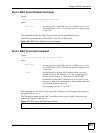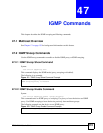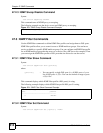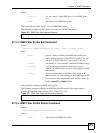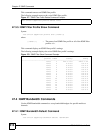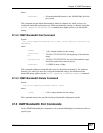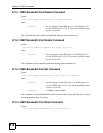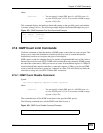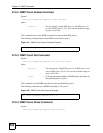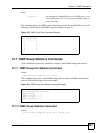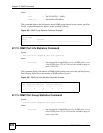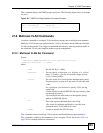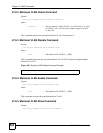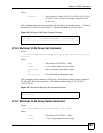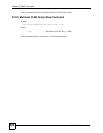
Chapter 47 IGMP Commands
IES-612-51A User’s Guide
319
where
This command displays the multicast bandwidth setting on the specified port(s) and whether
or not this setting is active. The following example displays the bandwidth budget for port 1.
47.6 IGMP Count Limit Commands
Use these commands to limit the number of IGMP groups a subscriber on a port can join. This
allows you to control the distribution of multicast services (such as content information
distribution) based on service plans and types of subscription.
IGMP count is useful for ensuring the service quality of high bandwidth services like video or
Internet Protocol television (IPTV). IGMP count can limit how many channels (IGMP groups)
the subscriber connected to a DSL port can use at a time. If each channel requires 4~5 Mbps of
download bandwidth, and the subscriber’s connection supports 11 Mbps, you can use IGMP
count to limit the subscriber to using just 2 channels at a time. This also effectively limits the
subscriber to using only two IPTVs with the DSL connection.
47.6.1 IGMP Count Disable Command
Syntax:
ras> switch igmpsnoop igmpcount disable <portlist>
where
This command turns off the IGMP count limit for the specified DSL port(s).
The following command turns off the IGMP count limit for port 4.
Figure 180 IGMP Count Disable Command Example
<portlist> =
You can specify a single DSL port <1>, all DSL ports <*>
or a list of DSL ports <1,3,5>. You can also include a range
of ports <1,5,6~10>.
Figure 179 IGMP Bandwidth Port Show Command Example
ras> switch igmpsnoop bandwidth port show 1
port enable bandwidth
------ ------ -----------
1 - 4096
<portlist> =
You can specify a single DSL port <1>, all DSL ports <*>
or a list of DSL ports <1,3,5>. You can also include a range
of ports <1,5,6~10>.
ras> switch igmpsnoop igmpcount disable 4



